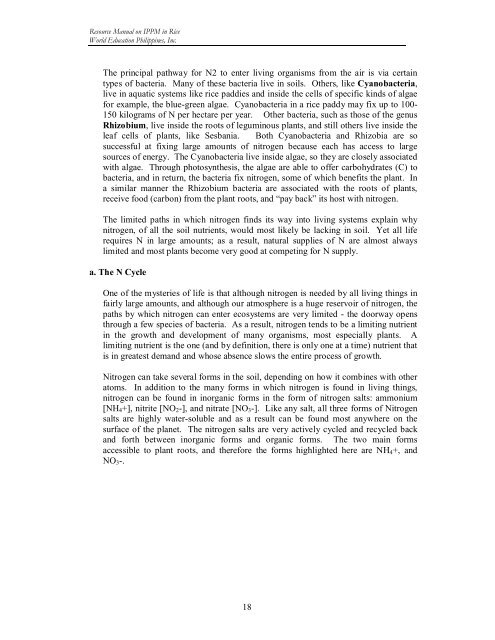(IPPM) in Vegetables - Vegetableipmasia.org
(IPPM) in Vegetables - Vegetableipmasia.org
(IPPM) in Vegetables - Vegetableipmasia.org
You also want an ePaper? Increase the reach of your titles
YUMPU automatically turns print PDFs into web optimized ePapers that Google loves.
Resource Manual on <strong>IPPM</strong> <strong>in</strong> Rice<br />
World Education Philipp<strong>in</strong>es, Inc.<br />
The pr<strong>in</strong>cipal pathway for N2 to enter liv<strong>in</strong>g <strong>org</strong>anisms from the air is via certa<strong>in</strong><br />
types of bacteria. Many of these bacteria live <strong>in</strong> soils. Others, like Cyanobacteria,<br />
live <strong>in</strong> aquatic systems like rice paddies and <strong>in</strong>side the cells of specific k<strong>in</strong>ds of algae<br />
for example, the blue-green algae. Cyanobacteria <strong>in</strong> a rice paddy may fix up to 100-<br />
150 kilograms of N per hectare per year. Other bacteria, such as those of the genus<br />
Rhizobium, live <strong>in</strong>side the roots of legum<strong>in</strong>ous plants, and still others live <strong>in</strong>side the<br />
leaf cells of plants, like Sesbania. Both Cyanobacteria and Rhizobia are so<br />
successful at fix<strong>in</strong>g large amounts of nitrogen because each has access to large<br />
sources of energy. The Cyanobacteria live <strong>in</strong>side algae, so they are closely associated<br />
with algae. Through photosynthesis, the algae are able to offer carbohydrates (C) to<br />
bacteria, and <strong>in</strong> return, the bacteria fix nitrogen, some of which benefits the plant. In<br />
a similar manner the Rhizobium bacteria are associated with the roots of plants,<br />
receive food (carbon) from the plant roots, and pay back its host with nitrogen.<br />
The limited paths <strong>in</strong> which nitrogen f<strong>in</strong>ds its way <strong>in</strong>to liv<strong>in</strong>g systems expla<strong>in</strong> why<br />
nitrogen, of all the soil nutrients, would most likely be lack<strong>in</strong>g <strong>in</strong> soil. Yet all life<br />
requires N <strong>in</strong> large amounts; as a result, natural supplies of N are almost always<br />
limited and most plants become very good at compet<strong>in</strong>g for N supply.<br />
a. The N Cycle<br />
One of the mysteries of life is that although nitrogen is needed by all liv<strong>in</strong>g th<strong>in</strong>gs <strong>in</strong><br />
fairly large amounts, and although our atmosphere is a huge reservoir of nitrogen, the<br />
paths by which nitrogen can enter ecosystems are very limited - the doorway opens<br />
through a few species of bacteria. As a result, nitrogen tends to be a limit<strong>in</strong>g nutrient<br />
<strong>in</strong> the growth and development of many <strong>org</strong>anisms, most especially plants. A<br />
limit<strong>in</strong>g nutrient is the one (and by def<strong>in</strong>ition, there is only one at a time) nutrient that<br />
is <strong>in</strong> greatest demand and whose absence slows the entire process of growth.<br />
Nitrogen can take several forms <strong>in</strong> the soil, depend<strong>in</strong>g on how it comb<strong>in</strong>es with other<br />
atoms. In addition to the many forms <strong>in</strong> which nitrogen is found <strong>in</strong> liv<strong>in</strong>g th<strong>in</strong>gs,<br />
nitrogen can be found <strong>in</strong> <strong>in</strong><strong>org</strong>anic forms <strong>in</strong> the form of nitrogen salts: ammonium<br />
[NH 4 +], nitrite [NO 2 -], and nitrate [NO 3 -]. Like any salt, all three forms of Nitrogen<br />
salts are highly water-soluble and as a result can be found most anywhere on the<br />
surface of the planet. The nitrogen salts are very actively cycled and recycled back<br />
and forth between <strong>in</strong><strong>org</strong>anic forms and <strong>org</strong>anic forms. The two ma<strong>in</strong> forms<br />
accessible to plant roots, and therefore the forms highlighted here are NH 4 +, and<br />
NO 3 -.<br />
18




![Section 4 [ PDF file, 252 KB] - The Field Alliance](https://img.yumpu.com/51387260/1/158x260/section-4-pdf-file-252-kb-the-field-alliance.jpg?quality=85)












